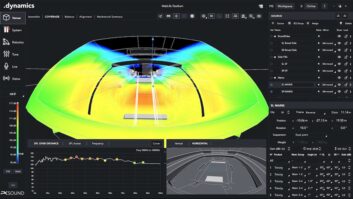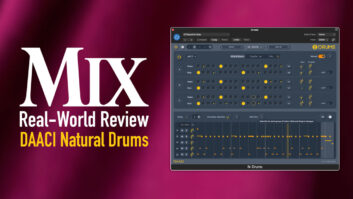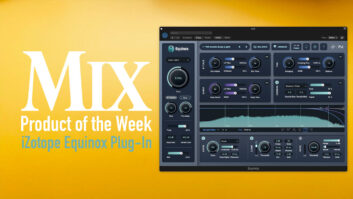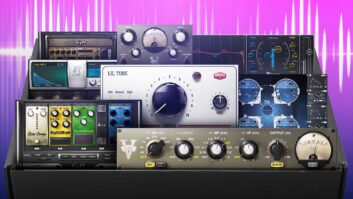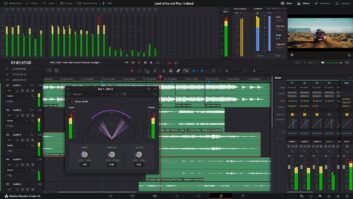In hisContinuing Adventures In Software, Rich Tozzoli finds an old friend showing up in places he couldn’t work before.
The Eventide Omnipressor is one of those quirky plug-ins that I love. I’ve often referred to it as a monster, because its unique compression/limiting/expansion can be so powerful that I can’t always tame it. But when I do, there is actually nothing else quite like it. So when I found out that Eventide will be releasing a Native version this month, I was happy for all the non-TDM users out there that will soon be able to explore its power. For those of you who are not familiar with this classic, let’s take a deeper look at it.
The Omnipressor actually started as a hardware box in 1971, and was in production up to 1984. According to Eventide, it was described as a “professional-quality dynamic modifier,” and it featured a unique Function control that allowed for Dynamic Reversal, Gate, Expansion, Control Centered (input level equals output level), Limiting and Infinite Compression.
With the software version, Eventide has remained true to the layout of the original and even retained its mono in mono out functionality. It’s got the standard Threshold, Attack and Release knobs, with a VU meter in the middle reading +/- 30 dB. There are knobs for Atten (attenuation) Limit and Gain Limit, and the aforementioned Function knob.
The Input Cal switches allow you to reduce the level feeding the unit by 10/20/30 dB (when both switches are pressed). Bass Cut/Nor switch determines the frequency response of the level detector circuit, where Bass Cut attenuates the bass signal for overall comp/expansion and the Meter Function switches select Input, Gain (relative) or Output. The Output/Cal switches let you increase the output level (10/20/30 dB) without affecting the compression ratios. The Atten Limit knob limits the max attenuation from 30 dB to 1 dB and the Gain Limit knob limits the max gain from 30 dB to 1 dB, both overriding the Function control. The green LED shows the unit is in gain-reduction mode and the red LED illuminates in gain-increase mode.
The Function knob is certainly the heart of this beast. According to the manual (sorry, it can say it better than I can): “When set fully counterclockwise, gain varies sharply from full attenuation to maximum gain as the Input Threshold is exceeded. As the control is rotated clockwise, this action becomes less sharp until the gain varies only a few dB from no input to full input.” But wait, there’s more. “At the knob’s centerpoint, the gain is constant, regardless of input level. As the knob is turned clockwise, gain begins decreasing with increasing input level. More rotation produces substantial compression until the point of infinite compression is reached and the gain decreases 1 dB for each dB of signal increase. Rotation past this point produces dynamic reversal, in which a high-level input produces a lower output than does a low-level input.”
As you might imagine after reading that, the Omnipressor is not a set-andforget unit. It has to be manipulated and mangled, and I’ll often find myself just twisting knobs and pressing buttons not knowing where the end result is headed. But then, you come across this sound, and the “s#)$* yeah” moment arrives. If you don’t want to do that, just call up some of the presets and learn from there.
“The Omnipressor is known in industry circles as the ultimate drum crusher,” notes Ray Maxwell, VP of sales and marketing at Eventide. On that point I totally agree, and that’s exactly how I tend to use it. When tracking drums, I like to include a mono room mic placed in a sweet spot in front of the kit, such as a large-diaphragm tube mic or classic ribbon such as the beyer M160 or Royer 121. By placing the Omnipressor across this mono mic in the mix, the kit tends to literally explode out of the speakers.
Sometimes it can grab the hi-hats too hard and make the sound harsh, so you have to play with the Threshold and adjust (like any other dynamic processor). One trick I learned with room mics is to record at a lower mic-pre input impedance, which lessens the highs. That lets me crush the track harder with the Omnipressor without the associated harshness. I also use it on guitar room mics, panned opposite of the guitar itself. Works wonders every time to add width, depth and a super-fat dimension.
Omnipressor was formerly TDM only, and was part of the Clockworks legacy package 2003. However, it has been part of all the Eventide bundles as they rolled it from the Clockwork Legacy package into Anthology, then into Anthology II.
At the $99 introductory price, the new Omnipressor Native version for AU, VST and AAX is a no-brainer. It’s one of those plug-ins you have to have in your toolbox. Trust me, you’ll find many ways to use it!

